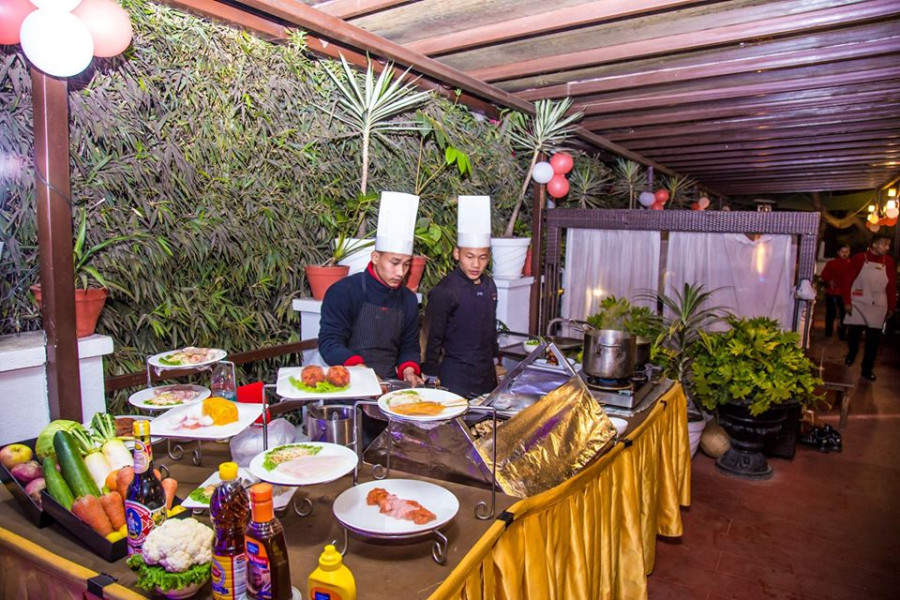Culture & Lifestyle
Covid-19 threatens the very survival of restaurants
Nepal's restaurant industry is one of the worst hit by the pandemic, and it may become one of the last ones to recover.
Tsering Ngodup Lama
In January 2018, 47-year-old Sonam Lama pooled in all her savings of Rs 700,000 and added that to a loan of Rs 150,000 to buy a restaurant on sale in Boudha. For Lama, the investment was huge, but the small eatery, Didiko Khajaghar, was located in an area that saw a lot of footfall, and she knew that if she worked hard enough getting the returns on the investment wouldn’t be very difficult.
Until January this year, a year into operations, Lama worked seven days a week, and her daily sales averaged Rs 6,000. After paying the rent, utility bills, and her three-member staff their salaries, she made a monthly profit of around Rs 35,000. She was well on her way to recouping her initial investment, and then Covid-19 happened. As the virus spread rapidly across the globe and cases started appearing in Nepal, the government announced a nation-wide lockdown on March 24.
The lockdown forced thousands of restaurants, from high-end to low-margin ones, like Lama’s, to close overnight, bringing Kathmandu’s thriving restaurant industry to a grinding halt, leaving business owners—and the thousands of workers who depend on the industry—deeply worried about the future.
“The first time I heard about the viral infection was in early February. It wasn’t something that worried me, let alone predict how it would go on to impact my life,” says Lama. By early March, the number of people visiting her restaurant had lessened significantly. For restaurants like Lama’s that have low profit margin and rely on a lot of footfall, it was a huge blow.
The day before the lockdown, all three of Lama’s staff asked to go on leave so that they could return to their village and be with their families. “I paid the staff their full month’s salary and dropped them to the bus stop. I remember telling them that things should be normal in a few weeks and that we could all resume work. It has been more than 50 days now,” says Lama.
For Bibhat Karki, who works as the food and beverage director at some of the high-end restaurants in Kathmandu—like the Embassy Restaurant, in Lazimpat; Oskar Bar and Grill, in Lazimpat; Tamarind, in Jhamsikhel and Lazimpat; and Zen Bistro and Cafe, in Bansbari—the slowdown in business started early. “After mid-February, we started seeing a decrease in footfall at all our five restaurants. By the end of February, business had reduced by 50 percent,” says Karki. “And then the lockdown was announced and we had to shut down all our five restaurants, leaving 200 of our employees out of work.”
The restaurant industry is one of the industries worst hit by Covid-19 across the globe. According to Restaurant and Bar Association of Nepal (REBAN), there are 3,300 registered restaurants in the country. “The industry directly employs more than 60,000 people, the majority of whom have been rendered jobless by the lockdown,” says Araniko Rajbhandari, president of REBAN.
One of those thousands is 28-year-old Suman Sapkota, who has worked in the restaurant industry for the past nine years. Until March this year, he was a service captain at a restaurant in Boudha. A day before the government announced the lockdown, Sapkota managed to return to his village in Kavrepalanchok. “Even though there was still a week left in the month, the restaurant’s owner gave me the full month salary,” says Sapkota.
But that was the last salary he has received.
“I am glad I managed to return to my village on time. Living in Kathmandu without pay would have been extremely challenging,” says Sapkota, who lives in a one-room rented accommodation in Gaurighat. “I don’t know when the lockdown will be lifted, and even if it is, I don’t know if I’ll still have a job waiting for me. I hope I do.”
While the restaurants have had zero revenue since the lockdown started, Rajbhandari says, they still continue to have operational costs. “Most restaurants spend about 18 to 22 percent of their revenue paying staff salaries, and despite the lockdown, many restaurants are still continuing to pay their staff,” says Rajbhandari.
For instance, according to Karki, the five restaurants that he manages have continued to pay the 200 employees that work with the eateries. “But if the current situation prolongs, I fear whether we’ll be able to continue to do so,” says Karki.
Another major concern, according to Rajbhandari, for restaurateurs is rent. “More than 90 percent of restaurants are located on rented premises,” says Rajbhandari, who says that he hasn’t heard of incidents of landlords pestering restaurateurs to pay rent for the past two months. “They have shown solidarity with restaurateurs, which is something we all need to do during these trying times.”
Lama says that she too hasn’t received a call from her landlord to pay the rent, yet. “But I will have to eventually pay him, and for small businesses like us, paying Rs 28,000 a month as rent when there is not a single rupee coming in is a big deal,” says Lama.
If the restaurant business is to survive the lockdown, restaurateurs say that the government must make it easier for restaurants to start takeaway or delivery services. According to Rajbhandari, some 15 restaurants in Kathmandu have started online deliveries. “But because of a lack of clarity regarding passes for vehicles delivering food, those who are operating online services are dealing with many challenges regarding travel timings,” says Rajbhandari.
Oskar Bar and Grill, one of the restaurants Karki manages, is one of the handful of restaurants that have started taking online orders. “We have had to do so so that we could at least cover some portion of our expenses. We started the service on May 10, and our daily turnover has been around Rs 20,000, which is less than 10 percent of the restaurant’s daily turnover before Covid-19,” says Karki.
But if the industry is to pull through the tough phase, the government will have a very important role to play, say restaurateurs. “By providing restaurateurs with working capital and a longer payback period can go a long way in helping the industry stay afloat,” says Rajbhandari.
Such measures would be crucial even after the lockdown is lifted and restaurants are allowed to resume work, as many restaurateurs say that it won’t be business as usual for them. “Until or unless we have a vaccine or a cure, which is highly unlikely in the near future, people will hesitate to eat out. What we can do from our part is have stringent safety and cleanliness measures in place so that those who do come to eat feel comfortable doing so,” says Rajbhandari.
And to ensure public health safety, the restaurant association is currently working with the Nepal Tourism Board and creating standard operating procedures for its member restaurants. “The road to normalcy is going to be long but until then what we can do is make sure we survive,” says Rajbhandari. “For the foreseeable future, restaurants will have to content if they even manage to make 50 percent of the revenue they had before Covid-19. Right now, the focus has to be on survival.”




 16.12°C Kathmandu
16.12°C Kathmandu















